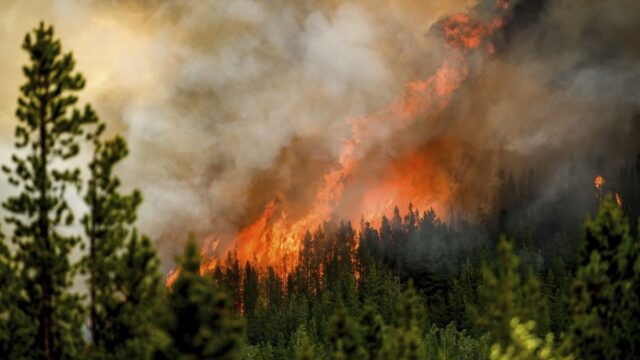The forest fires lasted for months and burned an area larger than Norway.
The wildfires that devastated Canada last year generated more carbon dioxide in the air than burning fossil fuels in India. In other words, the fire threw up almost four times as much carbon emissions to the atmosphere than the flights recorded in one year. It is the same amount of carbon dioxide that 647 million cars emit per year, according to data from the United States Environmental Protection Agency.
New data exposes the vicious cycle of forest fires: they are becoming more frequent due to the global warming, caused by the burning of fossil fuels that produces emissions. The forests eliminate many emissions from the atmosphere, so that when they burn they release this carbon, and their CO₂ absorption power disappears.
The Canadian wildfires accounted for 27% of the global tree cover loss last yearwhile it is normally close to 6%, according to research.
Why were the Canadian fires so extraordinary?
Canada fires in 2023 lasted months, They burned an area larger than that of Norway and the smoke spread to Europe.
Scientists at the World Resources Institute and the University of Maryland estimated that they put about 3 billion metric tons of carbon dioxide into the air, which accumulates heat, according to an update of the study published in Global Change Biology. The update has not been peer-reviewed, but the original study has.
The study’s lead author, James MacCarthy, and his colleagues estimated that the burned forests totaled an area of 77,574 square kilometers, six times more than the average from 2001 to 2022.
This surface is much larger than that of the forest fires common, and the researchers focused only on the loss of tree coverwhich is a larger effect, said study co-author Alexandra Tyukavina, a professor of geography at the University of Maryland.
“The loss of so much forest is very important and worrying“says Jacob Bendix, professor of Geography and Environment at Syracuse University, who was not involved in the study.
“Although the forest will regenerate, and the trees will grow back and accumulate carbon, the process will take decades at least, so there is a considerable gap between the addition of atmospheric carbon due to fires and the final removal, of at least part, by the regenerating forest. “So, over the course of those decades, the net impact of the fires is a contribution to the increase in temperatures.”
The forests “they remove a lot of carbon from the atmosphere, which is stored in branches, trunks, leaves and also in the soil. When burned, everything stored carbon returns to the atmosphere“explains James MacCarthy, lead author of the study and research associate of Global Forest Watch at the World Resources Institute.
When trees grow back, much of that carbon can be captured, MacCarthy said, adding that “it definitely has a impact on a global scale in terms of the amount of emissions that occurred in 2023.”
Why are forest fires dangerous to health?
It is not just about increasing gases that accumulate heat and losing forests, but also the health consequences, Tyukavina explained.
“Due to these catastrophic fires, the air quality in populated areas and cities was affected last year,” he said, mentioning the summer loaded with a kind of smog from New York. More than 200 communities with about 232,000 inhabitants had to be evacuated, according to another study not yet published or reviewed by Canadian forest and fire experts.
One of the authors of the Canadian study, fire expert Mike Flannigan of Thompson Rivers University in Kamloops, British Columbia, estimates the burnt surface twice as many as MacCarthy and Tyukavina.
“The 2023 fire season in Canada was exceptional for any time period,” Flannigan, who was not part of the World Resources Institute study, said in an email. “I think there will be more fires in the futurebut it will be rare for episodes like those in 2023 to take place.”
What role did climate change play in the fires?
Flannigan, Bendix, Tyukavina and MacCarthy stated that the climate change performance a prominent role in the great fire of Canada.
A warmer world means a longer fire season, more fires caused by lightning and, above all, drier wood and brush ready to burn “associated with temperature increase“said Flannigan. According to his study, the average temperature between May and October last year in Canada was 2.2 degrees Celsius higher than normal. According to MaCarthy, some areas of Canada recorded temperatures between 8 and 10 degrees Celsius higher than normal. average in May and June.
There is short-term variability within the trends, so it is difficult to blame the climate change of a specific year and the burned area. Geographic factors play an important rolebut “there is no doubt that climate change is the primary driver of the global increase in wildfires,” Bendix says in an email.
According to Tyukavina, with warming temperatures on the planet due to climate change, “it is likely that the ‘catastrophic years‘ occur more frequently and that we watch those longer episodes, more often.”








